A weekend in Lisbon
A weekend in Lisbon
Lisbon is a city where I had my first Erasmus experience, and I have to say that I am still in love with my Lisbon. This rather small, but very romantic, city, surrounded by Rio Tejo (or the Tagus river) and the ocean is a perfect destination for a weekend trip. And in this blog post, I would like to show you how to make the most out of your short stay in Lisbon.
I focused on seeing most of the city’s highlights on one day, and dedicating the second day to relaxing and possibly revisiting the spots that you really liked the previous day. Of course, you can always tailor the itinerary to your own liking, but this guide covers all the important sights, so you do not have to worry about missing anything crucial.
Getting there
The easiest way to reach Lisbon is simply to fly there. Most European low cost carriers will allow you to fly to Lisbon for less than one hundred dollars for a round trip. The two airlines that I used during my several trips to Lisbon, are EasyJet and TAP Portugal. While TAP Portugal can be a little more expensive, it allows you to have one free checked bag and two free carry on items. Meanwhile, if you are flying EasyJet, all you can take on board for free, is a small backpack. So if you are travelling with more baggage, I think the winner is clear.
Once you arrive to the Lisbon airport, there is no need to take a taxi to your hotel or whichever other place you are staying at. You can simply take the red metro line into the city. And, while you are at it, you can also buy a public transport pass, so you do not have to pay for each ride separately. Buying a multi-day pass will also save you some money.
Where to stay?
Lisbon has no shortage of cute places to stay, so all you need to do is figure out in which area you would like to stay. My three favourite areas are Baixa-Chiado, Bairro Alto and Santos, and they are all a walking distance to basically everything important in Lisbon.
If you are travelling on a budget, you can still stay in some of the cute little boutique hotels for a relatively low price. Baixa-Chiado area also has quite a few hostels, which allow you to spend a night there for less than thirty Euros per person.
Then, there is AirBnb, which is basically a platform where locals share their spare rooms or even whole apartments. And sometimes, places on AirBnb have great location and are cheaper than hostels, and also more convenient, because you get a private room, so it is worth checking both options before deciding.
How to get around?
Lisbon has, just like Barcelona, an excellent public transportation system. It is very cheap and reliable, and also easy to use. In addition to buses and metro, there is also a train that connects some parts of the city. Sometimes, you might have to combine some forms of public transportation to get to your destination, but I can assure you that you will never need to think about getting a taxi. You can even get from and to the airport using the metro!
So if you are planning to use public transportation, these are the two best options for passes that you have:
- The most convenient option is definitely the prepaid public transportation card. You basically pay fifty cents for a plastic card, and you reload the amount of money you wish to put on the card. One trip usually costs 1. 25 Euros, so if you load fifteen Euros on the card, you will be good for a few days.
- But since you will be in Lisbon just for the weekend, you can simply get two 24 - hour unlimited passes, and each will cost you six Euros. This option is a much better value for short stays, while it is not the most convenient for the long run.
How much will it cost you?
In general, Lisbon is not a very expensive city. Of course, there are always cheaper places, but if I compare the cost of living in Barcelona and the cost of living in Lisbon, Lisbon is much cheaper. If you are travelling by yourself, expect to spend between fifteen and fifty Euros per night for accommodation. A meal in a not - so - fancy restaurant will cost you between ten and fifteen Euros, and if you like beer, you are in luck - the Super Bock beer costs just one Euro in most places!
Day one - arrival
Once you land at Lisbon Portella airport, you can head towards the metro. Instead of paying for each individual ticket, you can purchase one of the options that I mentioned in the ‘How to get around’ chapter. If the place you are staying at, is far from the metro station (which is unlikely), you can always take the bus afterwards and save money on taxis. Bus stations are usually situated just a few steps away from every metro station.
Once you unpack and settle in, you can take a quick stroll around the streets nearby just to get a feeling of Lisbon, and then head to bed so you will be well rested for the following two days, that will be full of exploring.
Day two
Start your day at Marques de Pombal square - you can either get there by metro or by bus. Admire the great architecture around the square, and do not forget about the maze, and then walk up to the viewpoint, called Parque Eduardo VII - the view from the top is just superb. You will even be able to see the Tagus river (rio Tejo) in the distance.
In general, Lisbon is filled with amazing viewpoints, or miradouros, as they call them. And good news is that I included the best of them in this trip plan! So once you are done with admiring the amazing view, you can walk back down towards the Marques de Pombal square.
From there, walk towards Campo Pequeno, which is a concert arena with a little shopping center under it, that includes a very interesting store - Ale Hop. I am telling you, this store is the best place for funky birthday gifts, and it is not expensive either.
The walk from Marques du Pombal to Campo Pequeno will take you around twenty minutes. On the way there, you will notice some interesting buildings, and some great street art. One of the most memorable street art pieces there is definitely a big abandoned house - the paintings look like they are actually alive! I wonder how long it took the artist (or artists) to finish it.
Once you get to Campo Pequeno, take a metro to Cais do Sodre. You will then continue your exploring in Baixa-Chiado, which is the area with most sights. From Cais do Sodre, walk dowards Praca do Comercio, which is a beautiful square, right next to the Tagus river. And this is where you can get the most Lisbon - ish picture - stand in front of the statue, and make sure the background includes the yellow buildings in the background. For the ultimate picture, wait until the typical yellow tram passes by.
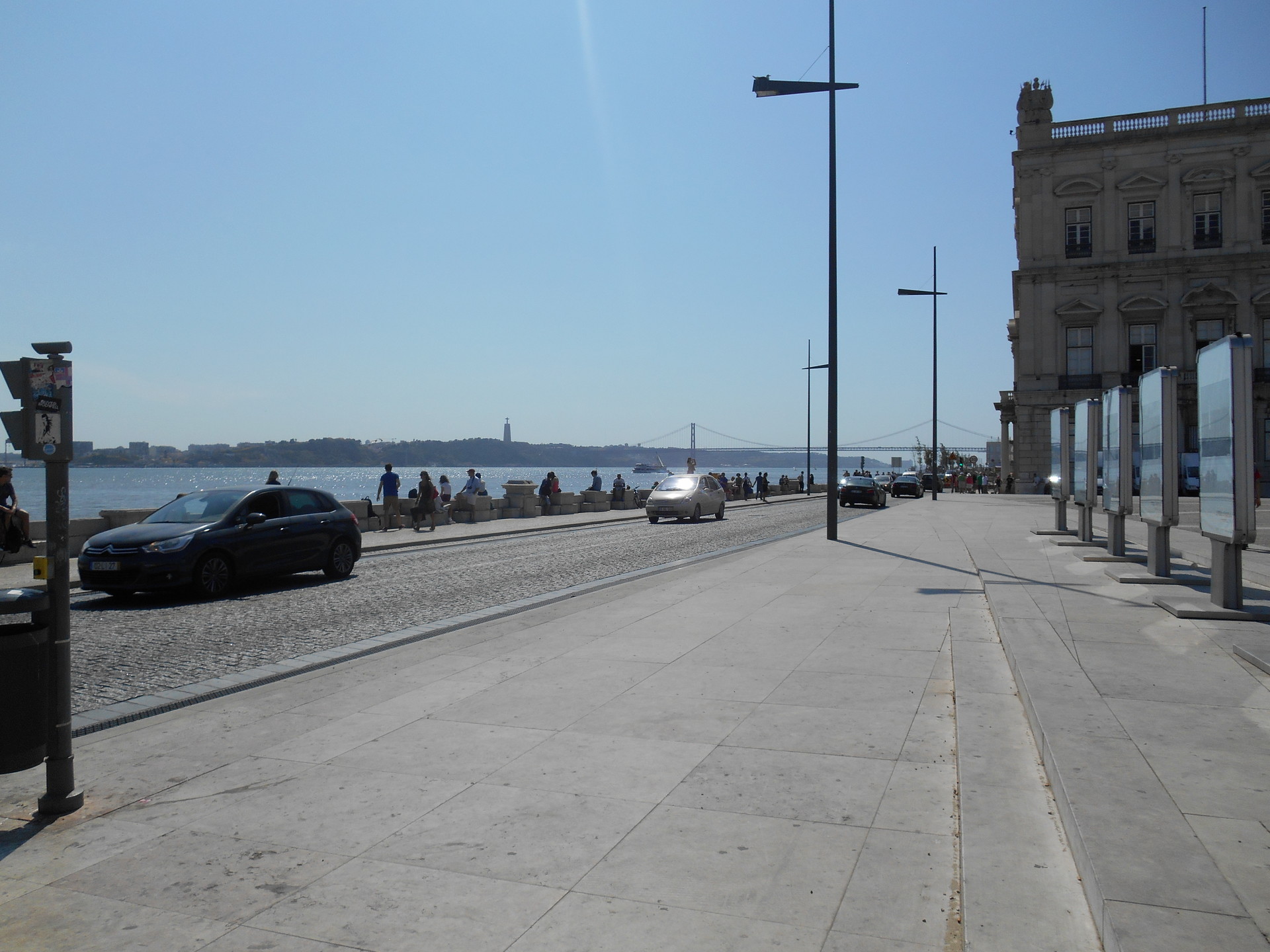
View of the Tagus river from Praca do Comercio.
From Praca do Comercio, walk up the Rua Ouro, which has some very interesting architecture, and some pretty cool shops. For example, a tattoo shop with skulls in the windows. At the end of Rua Ouro, another beautiful square will open up. This square is called Praca de Figueira, and the most interesting sight on it is definitely the doll repair shop.
No, I am not joking, this store actually repairs broken dolls, and, as you can probably imagine, the displays are quite haunting. Just an advice - if you had a few drinks at Bairro Alto, and you are passing the Doll repair shop on the way home, do not look inside. Because I guarantee you will have some nasty nightmares if you do.
Praca de Figueira is a busy square, and buses arrive and depart all the time, therefore, it is very loud and noisy there. But the next square you are about to see, is much quieter than that, and it is situated just a few steps away from Praca da Figueira.
The square I am talking about, is called Rossio square, and the tiles on the floor look like (very trippy) waves. If you are there during warmer months, take a seat on one of the benches and wait until ice cream vendors approach you. Their ice creams are cheap, but good, and you can treat yourself to one.
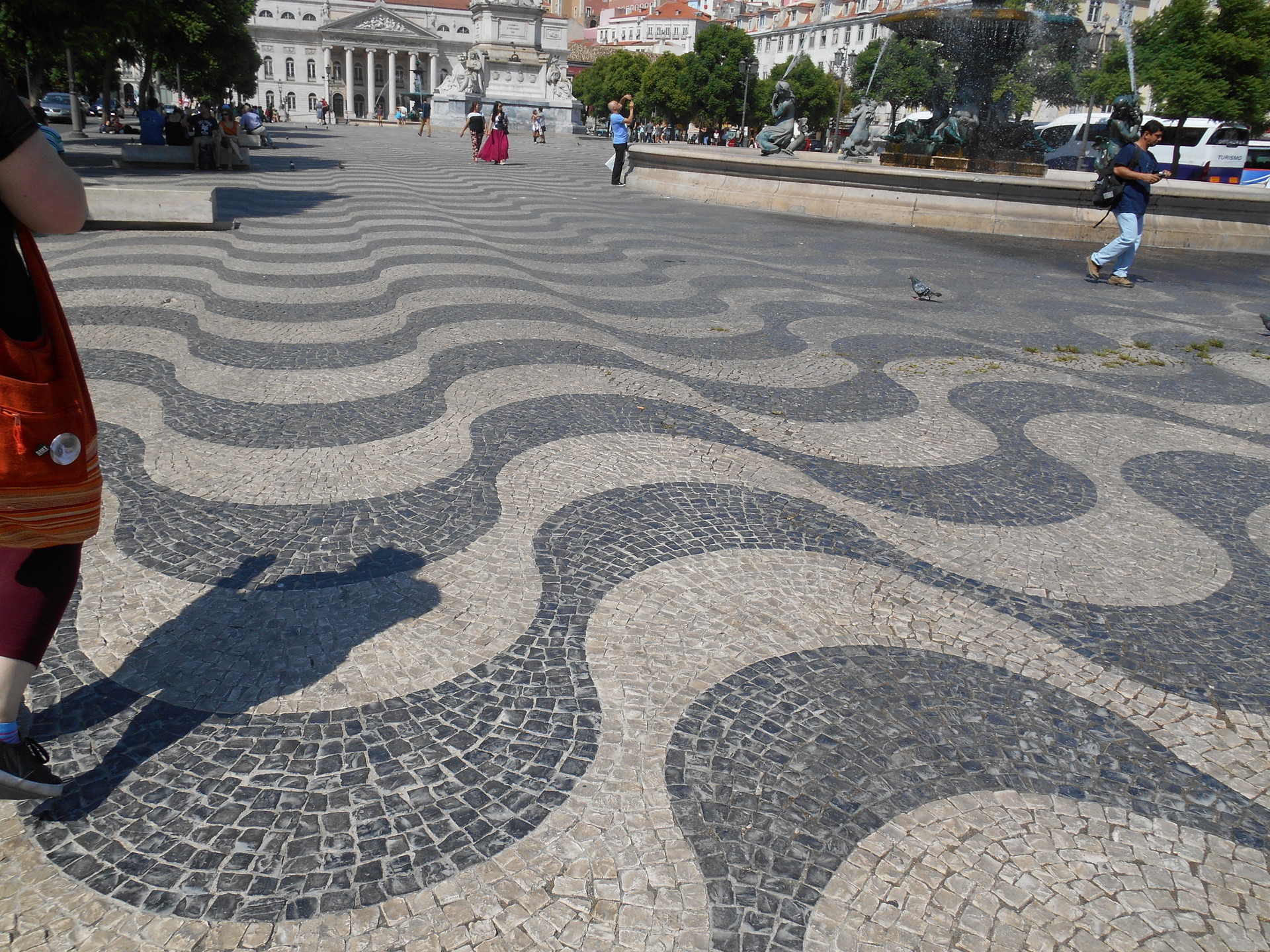
This is one of the most interesting squares I have been to - and the trippiest as well!
Rossio is also the square with a lot of pigeons, and sometimes, when you want to cross the square, you have to walk through a flock of them, and they will occasionally get scared and fly away, which is a very unpleasant experience. Rossio is also a home of a beautiful train station, from where you can take the train to Benfica, or further to the beautiful city of Sintra. If you have more time, you should definitely go to Sintra - it is such a beautiful city, and much less overwhelming than Lisbon.
Once you are done admiring the Rossio square’s beauty, you can head back to Praca da Figueira and take one of many steep side streets that will bring you up one of the Lisbon’s seven steep hills. It does not really matter which one you take, because they will all end up at the top of the same hill.
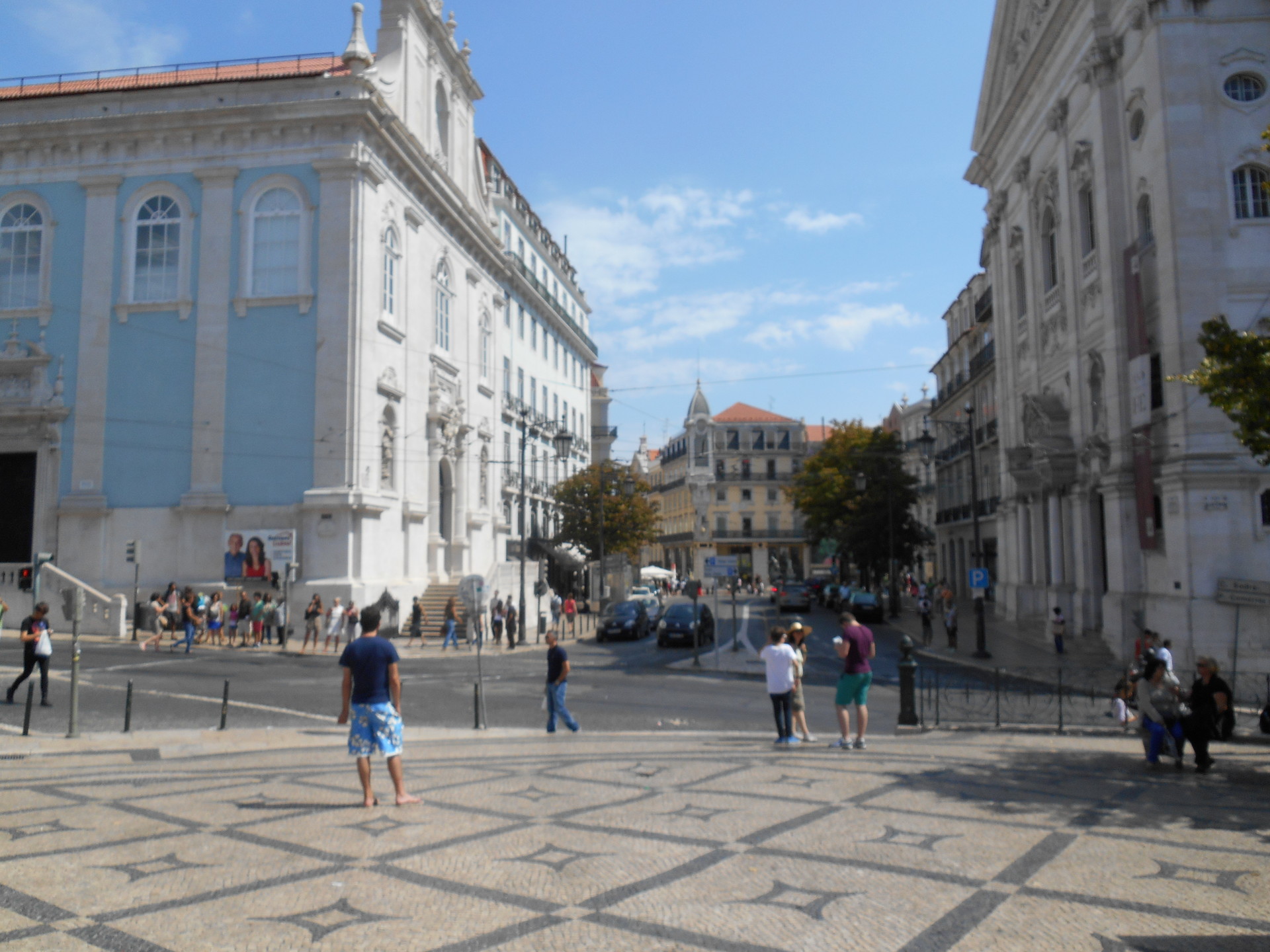
A classic view of Lisbon. Not bad, right?
On the way up, you can admire countless souvenir shops and listen to fado music, which is a typical Portuguese music. If you want a more unusual souvenir, you can buy a CD with fado music on it. The way up is also an opportunity for another ice cream. I do not know why are the ice creams in Lisbon so good, so have as many as you can. I am telling you, ice cream back at home will never be the same.
Two of my favourite viewpoints, or miradouros, in this area, are definitely Miradour das Portas do Sol and Miradour da Nossa Senhora do Monte. Miradour das Portas do Sol is common on Lisbon postcards, and once you see it, you will understand why. The two tall palm trees, framing the rooftops, and the seemingly endless Tagus river in the background give this place a magical feel.
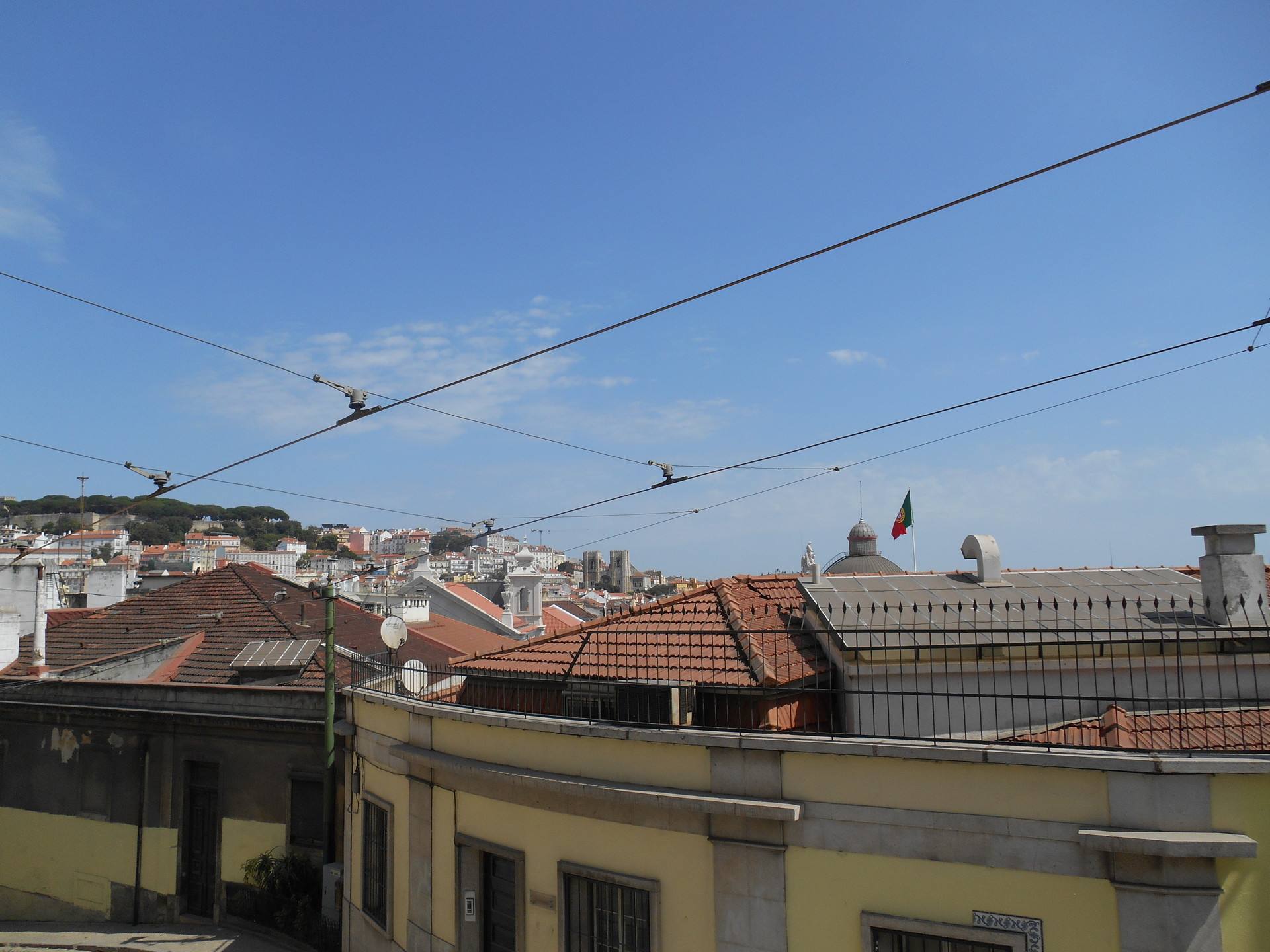
One of Lisbon's many viewpoints with rooftops in the distance.
Miradour da Nossa Senhora do Monte offers equally breathtaking views. From up there, you will be able to see a major part of Lisbon, with Tagus river and the 25th April bridge in the background, along with the Sao Jorge castle, and more. This viewpoint is equally beautiful during the day and at night, but the experience is, of course, more magical at night - just imagine all the city lights, flickering below you. You will feel like you are a king of the world.
After that, get lost in the narrow streets of Bairro Alto, and start planning which bars you will visit at night. And do not be afraid to wander all around Bairro Alto, it is perfectly safe, especially during the day. And trust me - the experience in Bairro Alto at night is nothing like the same place during the day. At night, there is usually so many people that you cannot even cross the street without feeling like you are going to drown in a crowd of people. But as unpleasant as it might sound, going to Bairro Alto at night is an essential part of travelling to Lisbon, regardless on how old you are.
Day three
Grab some breakfast in Lisbon’s many pastry shops, and do not forget some coffee! If you have not tried the famous egg custard pastry yet, called pastel de nata, you can try it today. Meanwhile one of these little tarts will not be enough to fill your stomach, they are a must - try when you are in Lisbon. My favourite breakfast food in Lisbon was a dish, called francesinha, which is basically a sandwich, full of ham, eggs, melted cheese and steak. Well, if you do not like meat, this is definitely not an option for you.
After a filling breakfast, take the bus to Costa de Caparica, a nearby beach, which will also allow you to see magnificent views of Lisbon from the April 25th bridge. Costa de Caparica is a pretty popular beach, and a good place to learn how to surf. And do not be discouraged to go there even in winter - Lisbon is warm year round, and meanwhile you might not be able to swim in December, you can still take a walk along this long stretch of sand and maybe even admire some surfers, braving the winter waves.
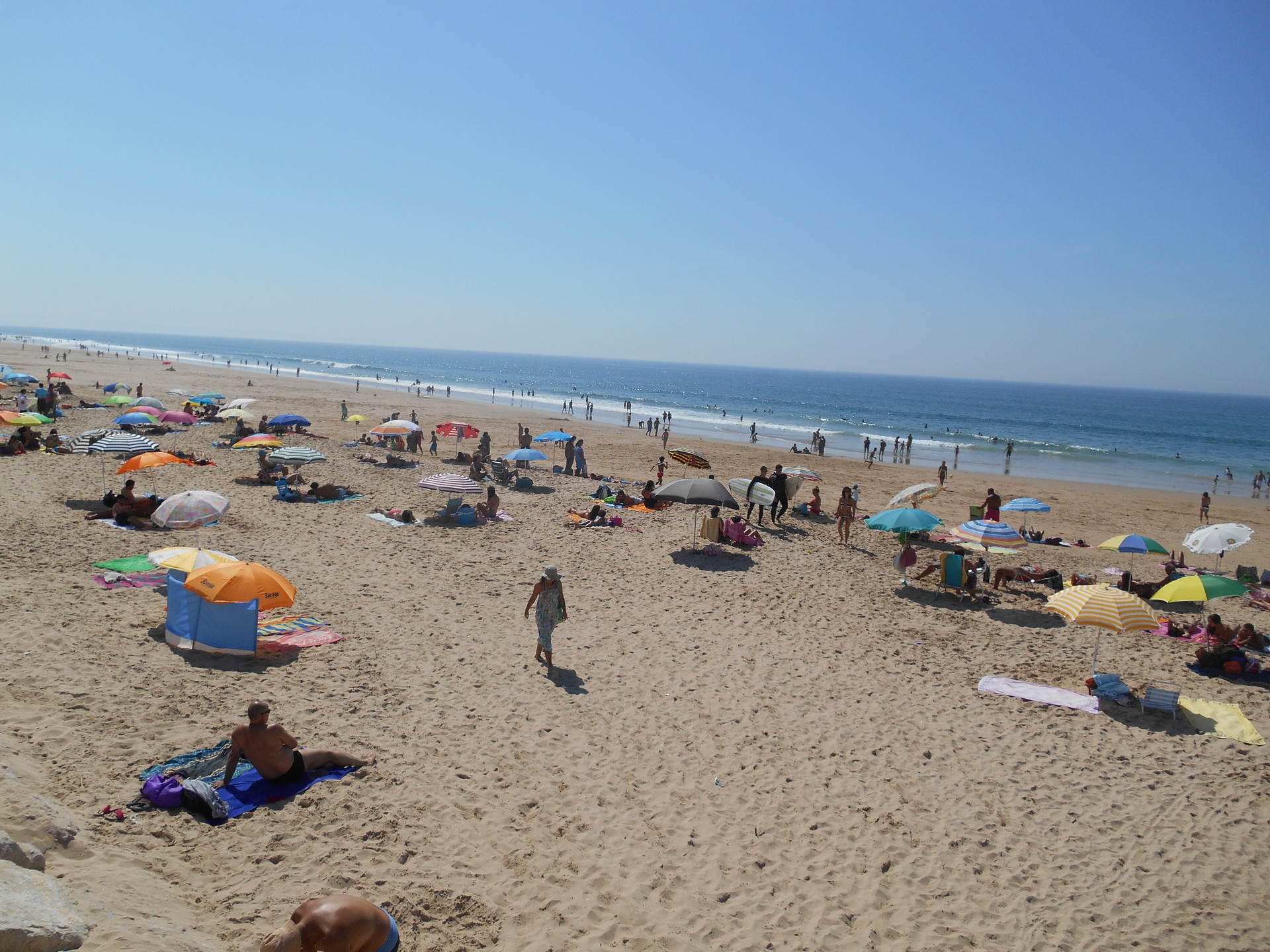
Costa de Caparica can be a little crowded in summer, but it is well worth a visit.
If you are going to Costa de Caparica in summer months, save your bus ticket - it will allow you to return to Lisbon for free if you show it to the bus driver. Unfortunately, this offer is not valid in autumn, winter and spring, but the bus tickets are not that expensive anyways.
Stay in Costa de Caparica for lunch - the seaside shops offer cheap food, which is finger - licking good. Oh, and do not forget to try a glass of freshly squeezed orange juice - Portuguese oranges are delicious! Head back to Lisbon after lunch, and start the second half of your day in Benfica - the home of the famous footballer. Even if you are not a Cristiano Ronaldo fan, this place is a must-see.
After taking some pictures of the stadium, cross the street and visit an amazing shopping centre, called Centro Commercial Colombo. I usually do not like to waste my time in shopping centers when I am on vacation, but Centro Commercial Colombo really is something special. And do not forget to check out the Primark store. Thank me later.
After satisfying your shopping cravings, head back to your place and put some nightlife outfit on. It is time to check out the Bairro Alto at night, more precisely, the infamous Erasmus corner. Do not forget to try the absinthe and the flag shots. I am sure you know what absinthe is, but let me tell you more about the flag shots.
Flag shots are a drink that has colours of different country flags in it. You can pick the flag you want, but let me warn you - these shots might look fruity and weak, but they do pack a punch! So if you have more than two, prepare for some light hangover tomorrow morning.
Day four - departure
Pack your bags, maybe have one last pastel de nata and some good espresso, then head towards the airport, and fly towards your next adventure. And I am pretty sure you will be thinking about returning to Lisbon on the way to the airport already.
By the way, a cheaper and quicker alternative of taking a taxi to the airport is simply taking the metro red line towards the airport. And guess what is the best thing about taking the metro to the airport: you do not need to worry about getting stuck in a traffic jam and potentially missing your plane!
A few tips for an unforgettable trip
The first and the most important tip - prepare for steep hills. I mean really steep hills. The part of Lisbon where most of the important sights are situated, is located on several hills. Seriously, the big hill that goes from Baixa-Chiado up to Bairro Alto is so steep that I had to stop several times before reaching the top because I was so tired.
Well, after a few walks up that hill, I built some resistance and it was not that hard anymore, but oh man… There is a tram that goes up and down that hill, if you really do not feel like conquering it by yourself. The problem is that this very tram is very popular and always crowded, and problem number two: it is quite expensive. So get yourself some comfortable walking shoes and go for it! You will not feel bad about eating all the sweet pastries after so much walking.
Be patient. In Lisbon, it seems like ‘Take it easy’ is the city’s motto, which is often also evident in the slow pace of the service. Do not be impatient and do not let that annoy you. You are on vacation, and this is just the way life in Portugal is.
Users of public transportation in Lisbon are often a target of pickpockets. The most common place for such events are the popular trams in the city centre. The problem is so persistent that there are multiple signs on each tram that warn you to watch your belongings. When I travel, I usually put all the valuables in a money belt or, worst case scenario, in an actual fanny pack, and carry useless stuff in a shoulder bag, such as sunglasses and a water bottle.
Do not be distraught by the sight of garbage bags, piled next to almost every building entrance. This is common in Lisbon - the city picks up the trash from each housefront. When I moved to Lisbon, this was so strange to me, because in my country, such a thing would be considered littering.
Not everybody in Portugal speaks English. In fact, it is quite common that when you ask someone something in English, whether on the street, or an employee in a bar or in a shop, the chances are that they will either just stare at you blankly, not understanding what you said, or answer you in Portuguese. So it is a good idea to learn some basic Portuguese phrases.
But the funny thing is that when I was trying to learn some Portuguese, and a part of it was ordering food and drinks, the servers would confirm the order or ask questions in English, although sometimes very broken. It certainly is possible to get by just with speaking English, but locals will appreciate even just a few words that you can say in their language.
And last but not least, have fun! Lisbon truly is a magical city, and I am pretty sure you will love it.
A short conclusion…
I think every single one of us has heard other people claim that they fell in love with the city of Paris. And before coming to Lisbon, I thought that was so silly. I am talking about the statement that someone can fall in love with a city. I have been to Paris before and it did not impress me at all.
But I knew on my first day in Lisbon that I could spend the rest of my life here without getting bored of this amazing city. And since my Erasmus exchange in Lisbon five years ago, I have revisited the city eleven times! I think that should tell you something about how great this place is.
Photo gallery
Content available in other languages
- Español: Un fin de semana en Lisboa
Want to have your own Erasmus blog?
If you are experiencing living abroad, you're an avid traveller or want to promote the city where you live... create your own blog and share your adventures!
I want to create my Erasmus blog! →









Comments (0 comments)